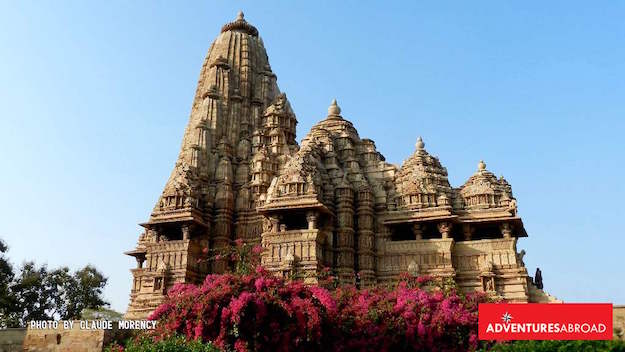India is home to nearly 1.3 billion people, the second largest on Earth, and the seventh largest in terms of area. Its landscape is beautiful and varied, from the western camel routes, dusty and desolate, to the massive Himalaya Mountains in the north, the lush, tropical forests deep in India’s south, and its eastern spiritual rivers, of which the Ganges is the most well known. Our India tours explore this complex, colourful and energetic country.
 The Khajuraho Group of Monuments are various Jain, Buddhist and Hindu temples built between 950 and 1050 AD in Madhya Pradesh, and are a UNESCO World Heritage Site.
The Khajuraho Group of Monuments are various Jain, Buddhist and Hindu temples built between 950 and 1050 AD in Madhya Pradesh, and are a UNESCO World Heritage Site.
You’ll find India in South Asia, tucked in between Pakistan to the west and Bangladesh to the east, Nepal and China to the North. To its south, India is blessed with abundant coastline, surrounded by the Arabian Sea, Indian Ocean and Bay of Bengal. The roots of history run deep in India, with archaeological evidence indicating the region has been inhabited for more than 30,000 years.
India was home to the bronze-age Indus Valley civilization, dating back to 3,000 BC. This puts India’s roots in the same timeframe as the Mesopotamians and ancient Egyptians.
Our India tours explore some of the fascinating history of this country, including two of the world’s major religions, which started in India, Buddhism and Hinduism. Two important stops on our tours are at Varanasi, the Hindu faith’s religious capital, and Sarnath, where Buddha is said to have preached for the first time, and heart of the Buddhist world.
India would eventually begin to trade with East Asia, as well as the Roman Empire, establishing itself as a strong, regional power. It also began to export its political systems and culture via its maritime power, to countries as far flung as Malaysia, the Philippines and Java, and closer neighbours such as Laos, Thailand, Cambodia, Myanmar and Vietnam.
Some of the sites worth visiting on our India tours include the temples of Halebid and Belur, which are carved exquisitely, but also the temples of Mamallapuram, where you will see scenes of everyday life in India at the time. The temples of Khajuraho are excellent examples of the skill of Indian architects of the time.
In the 10th century Islam reached India’s border in the north, where the Mughals would adopt it, and the 16th to 19th centuries saw it rule over large portions of the country. The Islamic capital was at Agra, and the Taj Mahal is considered by many to be the pinnacle of Islamic architecture at the time.
Europeans had already reached India before the Mughals. The British East India Trading Company established ports at Kochi, Chennai and Mumbai (Bombay). In 1498, the Portuguese Vasco da Gama established a port at Goa, on a search for “Christians and spices.”
As a result of European expansion, palaces and forts began to be built in response to these threats, but also the wealth created by trade. In the Rajasthan region one can see many palaces, with notable examples at Jodhpur, Jaipur and Udaipur.
On our India tours, you’ll quickly discover its impact on each of your senses, and you will feel its imprint on you for years to come.